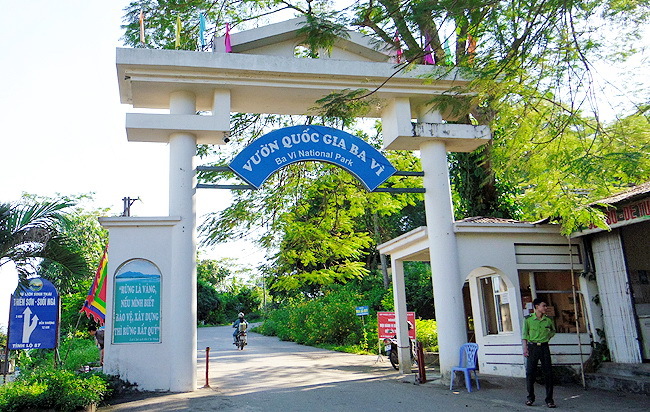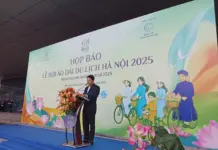Some 200 relics of French colonial buildings from a century ago have now become wonders for trekkers to discover.

Gateway to Ba Vi National Park
Tree roots engulfing the ruined architecture creates a mystical scene. Some parts of the buildings remain intact, revealing the French architectural style in their stairs, floors, pillars, and walls.
While many villas and mansions of French officials were destroyed during wartime, many have been preserved and are interesting detours for visitors.
From Height 600m to Height 700m, a buggy tour delivers tourists to French relics hidden deep inside the jungle, including a church, a cannon emplacement, a ladies’ camp, a mansion of an army colonel, and other villas scattered nearby the modern Melia Ba Vi Mountain Retreat, which was built on the foundations of an old French resort.
The Melia has a unique location amid the natural beauty of Ba Vi Mountain Range, blending a perfect fusion of French colonial architecture and the traditional architecture of Vietnam’s northern region.
Trekkers can discover various routes through the forests, such as the one traversing Ngoc Hoa Stream and bamboo forest.
Wild sunflowers, or dã quỳ, are scattered around from October to November. A rose myrtle species from Thailand blooms from the beginning of summer, with its purple colour representing love and loyalty. Meanwhile, golden shower trees bloom in early summer, giving tourists some great photos.
A conference on making the most use of the French architecture relics on Ba Vi Mountain was held recently in Hanoi, with the aim of acknowledging the cultural and historical value of the remnants and identifying how to revive this “sleeping beauty” and develop the site in a sustainable manner.
Initiated by the Vietnam Association of Architects (VNAA) in co-operation with Melia Hotels International Group, the conference took place in early September in Hanoi, gathering together 150 Vietnamese and foreign experts in architecture, culture, preservation, art, history, and tourism.
Many documents regarding the resort town built by the French on Height 400m, Height 600m, and Height 1,000m were revealed for the first time at the conference. These are evidence of harmony between Eastern and Western cultures, between the French lifestyle and local natural spaces.
“Anyone who visits the French relics on Ba Vi Mountain will realise that the town should be revived and its story told,” said Nguyen Tan Van, chairman of the VNAA.
“It is necessary to promote the site, restore its old buildings, and spread Ba Vi’s historical and cultural stories, but development must go with preservation, which is a key strategy to boost local tourism.”
“Our task is to identify the right way to make investments, respect nature and the environment, restore the relics, and add to the site while preserving the harmony between the jungle and the buildings.”
“It would be of great regret if the century-old remnants were to be consumed by the jungle and completely disappear.”
“Reusing old buildings in a positive way is a solid strategy for protecting heritage for present and future generations,” he said.
“Ba Vi Mountain is like nowhere else in Vietnam, with a French resort area built in harmony with nature and respectful of local culture. I support the idea of putting up new buildings on the foundations of old villas.
“The old architecture of the French is diverse and functional and includes villas, churches, libraries, kindergartens, and restaurants, so I would suggest highlighting them.”
Paredes added: “We can use eco-friendly materials, design new buildings in an old style to match the previous architecture, and create a comprehensive project wherein myths, history, nature, and luxury come together.
“Nestled amid Ba Vi Mountain Range and with fresh air and panoramic views of the plains, the site is the ideal getaway to relax and liven up your senses.”
Painter Thanh Chuong, meanwhile, said he felt moved upon seeing hundreds of ruins on Ba Vi Mountain. Traces of villas hidden among trees are evidence of the splendour of the past. What belongs to culture must be protected, but we must still promote its value. If not, days of yore will simply be buried forever beneath the roots of ever-growing trees.
“Ba Vi National Park is a precious primary forest, of which there are only a few left in Vietnam, and Ba Vi Mountain has an important place in terms of history, culture, and spiritual life for the Vietnamese people,” Chuong said.
“So, whatever we do, we must respect and protect the forest. I believe the operation of the Melia Ba Vi Mountain Retreat will be done in a proper manner. New buildings don’t harm the jungle, as they are built on the grounds of the demolished French buildings.”
Chuong also spoke of the lessons to be learned from overheated development at other mountainous tourism sites such as Tam Dao, Da Lat, and Sa Pa.
According to Dang Van Bai, a member of the Vietnam National Cultural Heritage Council, Ba Vi is like an oasis of relaxation. The French built villas that were suitable with the local climate and inspired by the beauty and simplicity of traditional Vietnamese wooden houses.
He suggested how best to promote the French relics as part of tourism in the national park.
“Such a project needs transparency in distributing the benefits between all parties and must be under the control of the local government and community. Ecological tourism should develop a sustainable local economy, with the exact impact on the environment determined beforehand,” Bai said.
“Ba Vi National Park now offers a range of tourism products to meet the preferences of different people, so I think the restoration of French relics should target luxury tourism only.”
The green mossy staircase to a French mansion gives tourists a panoramic view over Ba Vi Mountain Range and also the Đà River.
Villas blending into their surroundings help tourists experience Vietnam’s exotic nature and understand more about its history.
As a saying goes, it’s better to see something once than hear about it a thousand times.
VNS



